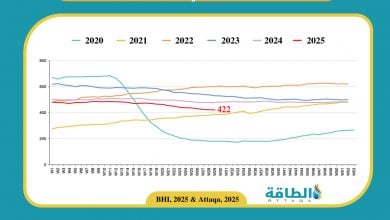The crude oil market has not witnessed fresh triggers to stoke pessimism (Article)
Vandana Hari

Benchmark sweet crude futures dived to fresh seven- and eight-month lows last week in a frenzied two-day sell-off amid renewed concerns over global oil demand erosion as economies begin to slow down.
There weren’t any fresh triggers in the oil market to stoke pessimism, but demand worries are now simply the default sentiment in the absence of any other major influencing factors.
The 8% cumulative plunge in Brent futures over Tuesday-Wednesday was likely exaggerated by algorithmic trading and bearish technical signals amid continuing thin trading volumes.
We expect crude to continue cascading lower into the end of the year unless unforeseen supply shocks create brief interludes of a reversal in trend.

Our base case is a gentle glide downwards in prices rather than a steep drop as there is still residual momentum in the post-Covid economic rebound around the world.
Europe may be unable to avoid sliding into a steep recession but other parts of the world are not in the same boat.
Also, with crude about 30% lower than the 14-year highs notched in early March, the pain of high fuel costs on consumers has moderated.
An easing of Covid-era supply chain disruptions and softening demand for consumer durables is also generally lowering inflationary pressures, so retail spending may not be about to fall off a cliff.
With Brent futures rebounded from Wednesday’s seven-month-low settle of $88 to settle well above $92 on Friday, OPEC+ can afford a wait-and-watch stance without risking the credibility of its pledge to cut output to avert further downward price spirals.
The consensus view in the market is that $90 is the floor the alliance will aim to defend. Though the “OPEC+ put” in crude prices had disappeared by the end of August, as we wrote last week, there appears to be some psychological support around $90, albeit one that could be breached more decisively unless the alliance is prepared to walk its talk.
Supply risks lurk in the shadows
Meanwhile, global oil supply risks are numerous and amplified by the razor-thin spare capacity limited to a few Middle Eastern producers and a stubborn and significant shortfall in OPEC/non-OPEC production against its monthly targets.
The alliance undershot its August production target by a record 3.61 million b/d, according to a survey by S&P Global Commodity Insights.
The chances of a revival of the Iran nuclear deal have faded. The Atlantic hurricane season, capable of disrupting US offshore oil and gas production as well the Gulf Coast refining sector and product exports, has been unexpectedly subdued so far, but it is not over yet.
A supply shock could erupt at any time, from any of the vulnerable spots. But it won’t be factored in until it happens.
Chinese lockdowns weigh on demand sentiment
In China, full and partial Covid lockdowns have been spreading across bigger swathes of the country as the government continues to pursue a zero-tolerance policy towards the coronavirus. This has now become another source of bearishness in the oil complex.
Local authorities across China are under increasing pressure to stamp out infections at all costs in the lead-up to the Communist Party congress starting on October 16, when President Xi Jinping is expected to secure an unprecedented third term in power.
Citizens have been told to minimise domestic travel during the Mid-Autumn festival over September 10-12 and the Golden Week holiday at the start of October.
Europe plans emergency measures
As the European Union hurtles towards an energy crisis caused by a sharp drop in Russian gas supplies, leaders of the bloc are scrambling to adopt coping measures.

At an emergency meeting on Friday, EU leaders supported sweeping interventions in the energy markets in the hope of reining in rocketing gas and electricity prices.
They tasked the European Commission with drafting plans to cap the revenues of non-gas producers of lower-cost electricity, offer emergency funds to power utilities under financial stress, require fossil fuel companies to make a “solidarity contribution”, and use the funds raised through energy companies’ revenue caps and contributions to help vulnerable households.
One of the bolder EU proposals that had gathered steam last week, namely capping the price of Russian gas, proved divisive and was set aside.
Russia accounted for 40% of EU’s imported gas before the Ukraine invasion but the proportion has now fallen to just 9%, while gas in storage is up to 82%, European Commission President Von der Leyen has said on Wednesday, in support of her team’s proposal to cap Russian gas import prices.
Russia would not supply gas, oil, coal or heating oil if there is a price cap imposed on the commodity, President Vladimir Putin warned on the same day, speaking at an economics forum in the far eastern city of Vladivostok.
The EU ministers backed the idea of broader gas price caps, a ceiling price for all gas imported into the EU, but the EC swiftly rejected it, warning that such a move would end up diverting LNG cargoes away from Europe.
The oil complex continues to shrug off Europe’s worsening gas and power woes for the time being, with the impact of any incremental oil consumption in the continent for replacing gas being dwarfed by wider concerns over a global demand erosion.
Amid a voluntary 15% reduction in gas consumption agreed by the European Union countries and industrial activity contracting in response to high power costs, it is unclear how much fuel replacement demand will flow into oil.
Vandana Hari is Founder and CEO of Vanda Insights, which provides macro-analysis of the global oil markets.
READ MORE...
- The fanciful goals of Green New Deal are nowhere in sight (Article)
- oil prices continues to be led by daily shifts in mood (Article)
- OPEC+ turns protective of limited spare capacity (Article)
- Russian Invasion of Ukraine accelerates higher fuel and electricity prices (Article)
- The Iranian gas dues problem and resupplying Iraq and Turkey (Article)









